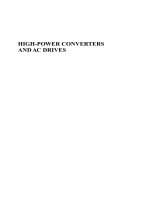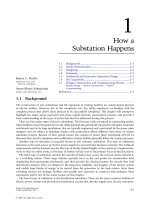SIEMENS SIMATIC power controller and 3 phase stepping motors
Bạn đang xem bản rút gọn của tài liệu. Xem và tải ngay bản đầy đủ của tài liệu tại đây (798.77 KB, 62 trang )
Overview
1
Functional description
2
SIMATIC
FM-STEPDRIVE
specifications
3
FM-STEPDRIVE/SIMOSTEP
Signal description
4
Mounting
5
Wiring
6
Setup
7
Status indicators and
troubleshooting
8
SIMOSTEP
specifications
9
Power Controller and 3-Phase
Stepping Motors
Functional description
Supplier Documentation FM-STEPDRIVE/SIMOSTEP
Stepping motor
parameters and
characteristics
Effectivity
Controller
SIMATIC
Edition 01.97
Software version
1
10
SINUMERIK® Documentation
Printing history
Brief details of this editor and previous editions are listed below.
The status of each edition is shown by the code in the "Remarks" column.
Status code in "Remarks" column:
A .... New documentation
B .... Unrevised reprint with new order No.
C .... Revised edition with new status
If factual changes have been made on the page since the last editon, this is
indicated by a new edition coding in the header on that page.
Edition
Order No.
Remarks
01.96
6SN1197-0AA70-0YP2
C
This documentation was created using WinWord V 6.0a,
Designer V 4.0 and Doc-To-Help V 1.6.
The reproduction, transmission or use of this document or its contents is not
permitted without express written authority. Offanders will be liable for damages.
All rights, including rights created by patent grant or registration of a utility modal or
design, are reserved.
© Siemens AG 1997. All Rights Reserved.
Other functions not described in this documentation might be executable in the
control. This does not, however, represent an obligation to supply such functions
with a new control or when servicing.
The contents of this publication has been verified for correspondence with the
hardware and software described. Nevertheless there may still be some
deviations. The information contained herein is verified on a regular basis, and
any corrections will be included in the subsequent editions. We should appreciate
any suggestions for improvement.
Subject to technical modifications.
Order no. 6SN1197-0AA70-0YP2
Printed in the Federal Republic of Germany
Siemens AG
Safety information
!
!
!
This manual contains safety texts which you should always observe for
your personal safety and to avoid damage. These texts are identified
and emphasized by a symbol and a heading which varies according to
the degree of danger:
Danger
means that death, serious injury or severe damage will result if
proper precautions are not taken.
Warning
means that death, serious injury or severe damage may result if
proper precautions are not taken.
Caution
means that minor injury or damage may result if proper precautions
are not taken.
Note
is used to give special emphasis to important information on the
product, handling the product or the relevant part of the
documentation.
Qualified personnel
Start-up and operation of the unit shall only be carried out by qualified
personnel. Qualified personnel in the sense of the safety information in
this manual are those persons who are authorized for setting up,
earthing and tagging equipment, systems and circuits according to
established safety practices.
Intended use
The following should be noted:
!
Warning
This equipment may only be used for the individual applications
specified in the catalog and in this documentation and only in
conjunction with Siemens approved or recommended third-party
equipment and components.
Adequate transport, storage, installation and mounting as well as
careful use and thorough maintenance are prerequisites for safe and
reliable operation of the product.
Trademarks
SIMATIC® and SINEC® are registered trademarks of the SIEMENS AG.
Copyright
Copyright © Siemens AG 1997 All Rights Reserved
This document may neither be reproduced nor made available to a
third party, its contents exploited or communicated unless explicitly
agreed. Any violation will give rise to damage claims. All rights
reserved, in particular with respect to potential patent issue or GM
registration.
Disclaimer
The contents of this publication has been verified for
correspondence with the hardware and software described.
Nevertheless there may still be some deviations. The information
contained herein is verified on a regular basis, and any corrections
will be included in the subsequent editions. We should appreciate
any suggestions for improvement.
Contents
01.97
Contents
Page
Overview...................................................................................................................1-1
Functional description.............................................................................................2-1
FM-STEPDRIVE specifications................................................................................3-1
3.1
Electrical data...................................................................................3-2
3.2
Mechanical data ...............................................................................3-5
3.3
Ambient conditions ...........................................................................3-5
3.4
Applicable standards, regulations, laws.............................................3-6
Signal description....................................................................................................4-1
4.1
Pulse interface..................................................................................4-2
4.2
Signal interface ................................................................................4-3
4.3
Signal timing diagrams .....................................................................4-5
Mounting ..................................................................................................................5-1
Wiring .......................................................................................................................6-1
6.1
FM-STEPDRIVE and SIMOSTEP wiring...........................................6-2
6.2
Wiring example for FM-353 and FM-NC ...........................................6-6
6.3
Wiring layout for control cabinet .......................................................6-9
6.4
Network wiring for several axes ........................................................6-10
6.5
Operating an axis in a safe working area ..........................................6-10
6.6
Accessories ......................................................................................6-12
Setup.........................................................................................................................
7-1
Status indicators and troubleshooting...................................................................8-1
SIMOSTEP specifications........................................................................................9-1
Stepping motor parameters and characteristics....................................................10-1
10.1
Basic concepts .................................................................................10-2
10.2
Torque characteristics ......................................................................10-3
6SN1197-0AA70-0YP2
vi
© Siemens AG 1997 All Rights Reserved
FM-STEPDRIVE/SIMOSTEP (FB)
1
Overview
© Siemens AG 1997 All Rights Reserved
FM-STEPDRIVE/SIMOSTEP (FB)
6SN1197-0AA70-0YP2
1-1
1 Overview
01.97
The FM-STEPDRIVE is a power controller for controlling a Siemens
SIMOSTEP 3-phase stepping motor . The FM-STEPDRIVE has been
designed as a module for the SIMATIC S7-300 automation system.
The SIMOSTEP motor series includes the following 3-phase stepping
motors:
Table 1-1
SIMOSTEP series stepping motors
Motor type
Nominal
torque
Nominal
current
SIMOSTEP 1FL3041
2 Nm
1.8 A
SIMOSTEP 1FL3042
4 Nm
2.0 A
SIMOSTEP 1FL3043
6 Nm
2.3 A
SIMOSTEP 1FL3061
10 Nm
4.1 A
SIMOSTEP 1FL3062
15 Nm
4.8 A
Figure 1-1
Reference literature
Order number
1FL3041-0AC310BG0
1FL3042-0AC310BG0
1FL3043-0AC310BG0
1FL3061-0AC310BG0
1FL3062-0AC310BG0
FM-STEPDRIVE power controller and SIMOSTEP motor
Elektrische Schrittmotoren und -Antriebe
Prof. Dr. Erich Rummich, TH Wien
Dr.-Ing. Ralf Gförer SIG BERGER LAHR
and two co-authors.
Expert-Verlag: ISBN 3-8169-0678-8
ỵ
6SN1197-0AA70-0YP2
1-2
â Siemens AG 1997 All Rights Reserved
FM-STEPDRIVE/SIMOSTEP (FB)
Functional description
© Siemens AG 1997 All Rights Reserved
FM-STEPDRIVE/SIMOSTEP (FB)
2
6SN1197-0AA70-0YP2
2-1
2 Functional description
01.97
The FM-STEPDRIVE power controller has interfaces, switches and
indicating elements arranged on the front panel as shown in figure 2-1.
The interfaces and parameter switches are visible when the front doors
are opened.
Figure 2-1
Pulse interface
FM-STEPDRIVE power controller
The pulse interface can be used for controlling the power controller
from the master positioning unit using clock signals. With each clock
pulse, the motor moves one step. In addition, a PWM signal can be
used for adjusting the phase current of the stepping motor between 0
and 100 %.
Input signals:
PULSE (clock), DIR (sense of rotation), ENABLE
(enable), PWM (current control).
READY1_N (readiness).
Output signal:
Signal interface
The GATE_N input of the signal interface can be used for enabling or
disabling the clock signals for motor control fed to the PULSE input. In
addition, the ZERO output can be used for evaluating the zero signal of
the internal ring counter.
Input signal:
Output signals:
Mains and
intermediate circuit
connection
GATE_N (enabling/disabling the clock signal)
ZERO (ring counter zero signal), READY2
(readiness),
MSTILL (Motor standstill)
The mains connection supplies the power controller with 115 V or 230
V AC. The intermediate circuit connection may be used for dissipating
surplus recovery energy of the motor.
6SN1197-0AA70-0YP2
2-2
© Siemens AG 1997 All Rights Reserved
FM-STEPDRIVE/SIMOSTEP (FB)
01.97
2 Functional description
Motor connection
A 3-phase stepping motor of the SIMOSTEP series can be connected
to the motor connection.
Current and
parameter switches
These switches are used for setting the motor phase current, the
number of steps (500, 1000, 5000, 10 000 steps/revolution) and the
current reduction
(to 60 % at motor standstill).
LED status
indicators
To indicate readiness and any malfunctions (short-circuit between
motor phases, supply overvoltage/undervoltage, power controller
overtemperature).
Fan
A fan is installed in the FM-STEPDRIVE power controller.
The block diagram shown in figure 2-2 illustrates the most important
functional groups of the FM-STEPDRIVE power controller.
© Siemens AG 1997 All Rights Reserved
FM-STEPDRIVE/SIMOSTEP (FB)
6SN1197-0AA70-0YP2
2-3
2 Functional description
Figure 2-2
01.97
FM-STEPDRIVE block diagramỵ
6SN1197-0AA70-0YP2
2-4
â Siemens AG 1997 All Rights Reserved
FM-STEPDRIVE/SIMOSTEP (FB)
FM-STEPDRIVE specifications
3.1
Electrical data...................................................................................3-2
3.2
Mechanical data ...............................................................................3-5
3.3
Ambient conditions ...........................................................................3-5
3.4
3
Applicable standards, regulations, laws.............................................3-6
© Siemens AG 1997 All Rights Reserved
FM-STEPDRIVE/SIMOSTEP (FB)
6SN1197-0AA70-0YP2
3-1
3 FM-STEPDRIVE specifications
3.1
01.97
Electrical data
Mains connection
Mains voltage
115 V or 230 V AC
Tolerance: -20% / +15%
Frequency range: 47 Hz to 63 Hz
External back-up fuse
16 A max. ("K" characteristic)
Input current
8 A max. at 115 V/4.5 A at 230 V
Starting current
75 A max.
Mains buffering time
> 10 ms at motor standstill
Maximum power loss
Intermediate circuit
connection
80 W
Intermediate circuit voltage
160 V to 485 V DC
Open-close cycle (during operation and after fault rectification)
>5s
Phase current
1.7 A to 6.8 A
6.8 A max. at an ambient temperature of 50°C
and vertical mounting position
4.8 A max. at an ambient temperature of 60°C
and vertical mounting position
4.8 A max. at an ambient temperature of 40°C
and horizontal mounting position
Motor voltage
Motor connection
3 x 325 V (connected to mains)
Motor cable
Trailing cable with double shield
Length
Wire cross-section
6SN1197-0AA70-0YP2
3-2
3 x 1.5 CC
50 m max.
2
3 x 1.5 mm
© Siemens AG 1997 All Rights Reserved
FM-STEPDRIVE/SIMOSTEP (FB)
01.97
3 FM-STEPDRIVE specifications
Pulse interface
Note
All signals are PELV (protected extra low voltage) signals as defined
by VDE 0160.
Pulse interface inputs
PULSE (clock), DIR (sense of rotation), ENABLE (power controller
enable), PWM (current control). For a signal description, see chapter 4.
5 V optocoupler inputs:
Voltage control:
Uhigh, min
=
2.5 V
Uhigh, max
= 5.25 V
Ulow, max
=
0.4 V
Ulow, min
= -5.25 V
Imax = 30 mA
Current control:
Ihigh, min
=
7 mA
Ihigh, max
= 25 mA
Ilow, max
= 0.2 mA
Ilow, min
= -25 mA
Umax = 5.25 V
Note
It is recommended to use push-pull control for reasons of noise
suppression.
Pulse interface output
READY1_N (readiness). For a signal description, see chapter 4.
Optocoupler output (no reverse-polarity protection, not short-circuit
protected):
Uce:
Uce,sat:
!
30 V max.
< 1.0 V at 10 mA
Warning
This output is not short-circuit protected and does not feature
reverse-polarity protection.
© Siemens AG 1997 All Rights Reserved
FM-STEPDRIVE/SIMOSTEP (FB)
6SN1197-0AA70-0YP2
3-3
3 FM-STEPDRIVE specifications
01.97
Signal interface
Note
Alls signals are PELV (protected extra low voltage) signals as defined
in VDE 0160.
Signal interface input
GATE_N (enable/disable the clock signal). For a signal description, see
chapter 4.
24 V standard PLC optocoupler input:
Uhigh, min = 15 V
Uhigh, max = 30 V
Ulow, max = 5 V
corresponds
Ulow, min = -3 V
Ihigh, min =
Ihigh, max =
Ilow, max =
2 mA
15 mA
0.2 mA
Input open
Ilow, min =
-15 mA
to low signal.
Max. transient overvoltage
35 V/500 ms
Signal interface outputs
READY2 (readiness), ZERO (ring counter zero signal), MSTILL (Motor
standstill). For a signal description, see chapter 4.
24 V standard PLC output READY2 (overload and short-circuit
protected):
Uhigh
24 V supply voltage
Voltage drop
3 V max. at 70 mA
Output current
70 mA
Sustained short-circuit current
0.6 A max.
Peak current
5 A max. for 50 ms
Ulow
Output open
Leakage current
150 µA max.
24 V standard PLC output ZERO (overload and short-circuit protected):
Voltage drop
3 V max. at 30 mA
Output current
30 mA max.
other data as for output READY2
External 24 V supply for signal interface
Note
The 24 V voltage supply must meet the specifications of DIN 19240.
Voltage range
Ripple
Input current
Transient overvoltage
6SN1197-0AA70-0YP2
3-4
18.5 V to 30.2 V DC
3.6 Vpp
1.5 A max.
35 V / 500 ms max.
© Siemens AG 1997 All Rights Reserved
FM-STEPDRIVE/SIMOSTEP (FB)
01.97
3.2
3 FM-STEPDRIVE specifications
Mechanical data
Dimensions (H x W x D)
125 x 80 x 117 mm
Weight
3.3
890 g
Ambient conditions
Figure 3-1
Interrelation between phase current and ambient temperature
Non-condensing
Transport and storage temperature
-40°C to +70 °C
Vibration strain during operation
10 Hz to 58 Hz
0.075 mm deflection
over 58 Hz to 500 Hz
8.9 m/s2
Vibration strain during transport (packaged)
5 Hz to 9 Hz
over 9 Hz to 500 Hz
Shock
15 g
Free fall
non-packaged
packaged
3.5 mm deflection
10 m/ s2
11 ms
100 mm
500 mm
Drop and topple admissible
Continuous sound pressure level
© Siemens AG 1997 All Rights Reserved
FM-STEPDRIVE/SIMOSTEP (FB)
<50 dB(A)
6SN1197-0AA70-0YP2
3-5
3 FM-STEPDRIVE specifications
3.4
01.97
Applicable standards, regulations, laws
The following standards, regulations and laws must be observed
when operating the FM-STEPDRIVE:
• DIN EN 60204 Part 1 (VDE 0113)Electrical equipment of machines
• DIN VDE 0100
Erection of power installations with
nominal voltages up to 1000 V
• DIN VDE 0106
Protection against electric shock
• DIN VDE 0470 (and: IEC 529)
IP degrees of protection
• DIN VDE 0875 (EN 55011)
Radio interference suppression of
electrical appliances and systems
• DIN EN 954-1
Safety of machines
Safety-related parts of
control systems
General design guidelines
If you intend to use the FM-STEPDRIVE power drive in a residential
area, the limit values of the following standards must also be observed:
• EN 60555
Disturbances in electricity supply
networks caused by household
appliances and similar equipment
• EN 55022, Class B
Limit values and measurement
methods for information
technology
equipment
• DIN EN 61000 Part 3-2
Electromagnetic compatibility
In case of high interference levels, additional measures must be taken.
We recommend to provide for EMC design of cabinets, e.g. 8MC
cabinets,
(-> catalog NV 21).
The following standards, regulations and laws have been
observed when developing the FM-STEPDRIVE:
• UL 508
Industrial control equipment
ã CSA C22.2 No 142
Process control equipment
ỵ
6SN1197-0AA70-0YP2
3-6
â Siemens AG 1997 All Rights Reserved
FM-STEPDRIVE/SIMOSTEP (FB)
4
Signal description
4.1
Pulse interface..................................................................................4-2
4.2
Signal interface ................................................................................4-3
4.3
Signal timing diagrams .....................................................................4-5
© Siemens AG 1997 All Rights Reserved
FM-STEPDRIVE/SIMOSTEP (FB)
6SN1197-0AA70-0YP2
4-1
4 Signal description
01.97
The signals and timing diagrams for the pulse and signal interfaces are
described in the following sections.
4.1
Pulse interface
The pulse interface has four 5 V optocoupler inputs and one
optocoupler output.
Note
The technical data of the pulse interface are described in chapter 3.
The signal timing of the inputs/outputs is described in chapter 4.3.
Inputs:
PULSE (clock)
To start motor shaft rotation, rectangular clock pulses must be supplied
to the PULSE input. Each positive pulse edge triggers one motor step
if the power controller is in ready status and the GATE_N input is
energized (24 V).
The sense of rotation is preset with the direction input (DIR).
DIR (sense of rotation) When the DIR signal input is deenergized, the motor turns in a
clockwise direction (as seen from front towards motor shaft). When this
signal input is energized, the motor turns in a counterclockwise
direction (as seen from front towards motor shaft). The sense of
rotation can also be inverted by interchanging two motor phase leads.
ENABLE (enable)
When the ENABLE input is energized, the power controller is enabled.
After approx. 500 ms, the power controller reports readiness via the
READY1_N and READY2 outputs and the motor is energized. If 24 V
are present at the GATE_N input of the signal interface, clock pulses
can be supplied to the PULSE input.
PWM (current control) The set motor phase current can be modified using a pulse width
modulation signal on the PWM input in the range from 0% to 100%
(frequency range
10 kHz to 20 kHz). The phase current is determined by the pulse/pause
ratio
of the PWM signal. If the signal input is deenergized, the set phase
current flows. If the signal input is energized, the motor phase current
is switched off. When the motor is stopped, it does not have any
holding torque.
Output:
READY1_N (readiness) When the ENABLE input is activated, the power controller reports
readiness via the READY1_N output. When the power controller is
ready, the READY1_N output has low resistance. If 24 V are present at
the GATE_N input of the signal interface, clock pulses can be supplied
to the PULSE input.
In case of a power controller fault, or if a power controller enable signal
has not been received via the ENABLE input, the READY1_N output
has high resistance.
6SN1197-0AA70-0YP2
4-2
© Siemens AG 1997 All Rights Reserved
FM-STEPDRIVE/SIMOSTEP (FB)
01.97
4.2
4 Signal description
Signal interface
The signal interface has one 24 V optocoupler input and two
optocoupler outputs.
Note
The technical data of the pulse interface are described in chapter 3.
The signal timing of the inputs/outputs is described in chapter 4.3.
Input
GATE_N
With 24 V at the GATE_N input, the pulses active on the PULSE input
are
(enable/disable pulses) used for controlling the stepping motor. With 0 V or open input
GATE_N,
active pulses are disabled. This function can be used in a multi-axis
system for
selecting individual axes.
Outputs
ZERO (ring counter
output.
zero signal)
evaluating the
When the internal ring counter is zero, 24 V are present on the ZERO
Reference movements with step accuracy can be performed by
ZERO signal. At a motor speed of 300 revolutions/minute, the pulse
width of
the ZERO signal is equivalent to the duration of the PULSE signal
period.
At a higher motor speed, the pulse width of the ZERO signal is
reduced.
READY2
readiness
(readiness)
are present
When the ENABLE input is activated, the power controller reports
via the READY2 output. When the power controller is ready,
24 V
on the READY2 output. If 24 V are present at the GATE_N input of the
signal
interface, clock pulses can be supplied to the PULSE input.
In case of a power controller fault, or if a power controller enable signal
has
not been received via the ENABLE input, the READY2 output has high
resistance.
MSTILL
signal
(Motor standstill)
Deactivating the clock signal on the PULSE input or disabling the clock
via the GATE_N input will stop the motor.
At 0 V or if the GATE_N input is open, 24 V are present at the
MSTILL
output; the motor shaft cannot move.
© Siemens AG 1997 All Rights Reserved
FM-STEPDRIVE/SIMOSTEP (FB)
6SN1197-0AA70-0YP2
4-3
4 Signal description
01.97
Applying 24 V to the GATE_N input is acknowledged by 0 V on
the MSTILL
output, and the motor shaft can move again.
6SN1197-0AA70-0YP2
4-4
© Siemens AG 1997 All Rights Reserved
FM-STEPDRIVE/SIMOSTEP (FB)
01.97
4.3
4 Signal description
Signal timing diagrams
The timing diagrams below illustrate the timing of the input/output
signals of the pulse and signal interfaces.
Figure 4-1
ENABLE/READY timing diagram
Figure 4-2
PULSE/DIR/GATE_N timing diagram
Figure 4-3
PWM or ENABLE and motor phase current timing diagram
Figure 4-4
GATE_N/MSTILL timing diagram
ỵ
â Siemens AG 1997 All Rights Reserved
FM-STEPDRIVE/SIMOSTEP (FB)
6SN1197-0AA70-0YP2
4-5
5
Mounting
© Siemens AG 1997 All Rights Reserved
FM-STEPDRIVE/SIMOSTEP (FB)
6SN1197-0AA70-0YP2
5-1
5 Mounting
01.97
!
Danger
Voltage must be disconnected whenever mounting work is carried
out.
Figure 5-1
Mounting the FM-STEPDRIVE power controller
Mount the FM-STEPDRIVE as follows:
1. Hook the FM-STEPDRIVE to the mounting rail and let it down.
2. Fasten the FM-STEPDRIVE using the two screws at the bottom of
the unit.
Note
A fan is installed in the power controller. When mounting, leave 5 cm
of space for the air flow at the top and bottom of the unit.
Units must not be mounted on top of each other without a partition.
ỵ
6SN1197-0AA70-0YP2
5-2
â Siemens AG 1997 All Rights Reserved
FM-STEPDRIVE/SIMOSTEP (FB)
6
Wiring
6.1
FM-STEPDRIVE and SIMOSTEP wiring...........................................6-2
6.2
Wiring example for FM-353 and FM-NC ...........................................6-6
6.3
Wiring layout for control cabinet .......................................................6-9
6.4
Network wiring for several axes ........................................................6-10
6.5
Operating an axis in a safe working area ..........................................6-10
6.6
Accessories ......................................................................................6-12
© Siemens AG 1997 All Rights Reserved
FM-STEPDRIVE/SIMOSTEP (FB)
6SN1197-0AA70-0YP2
6-1









